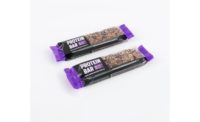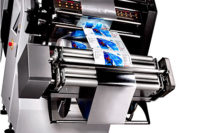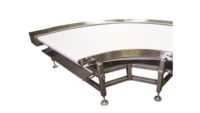With flexibility, quick changeover and easy-to-clean features, horizontal packaging systems are in great demand. They not only help keep costs in check, they provide smooth operation, environmental benefits and higher efficiencies and speeds.
When it comes to horizontal packaging equipment, bakery and snack food plant managers want flexible systems that can handle multiple package formats and product types. Quick changeover on easy operation and maintenance are on their list of must-have features, too. Plant managers also are looking for easy-to-clean equipment designed to comply with new food-safety regulations.
“Bakeries and snack food manufacturers are demanding greater flexibility in the packaging equipment they purchase today,” says Terry Zarnowski, sales and marketing director of Schneider Packaging Equipment Co. Inc., Brewerton, N.Y. “They want equipment that’s capable of handling a wider range of product formats and packaging options. Our customers are producing more stock-keeping units (SKUs), driving shorter production runs and at higher production speeds, as upstream processes are improved.” Such manufacturing requires fast-changeover equipment that’s easy to operate and maintain.
The trend toward healthy eating is leading to portion control, with smaller package sizes gaining in popularity, according to Paul Garms, marketing manager, Bosch Packaging Technology, Waiblingen, Germany. (Its U.S. office is in New Richmond, Wis.) This results in higher package-per-minute requirements at the packaging machinery level. Easy-opening and reclosable features are another trend, he adds, driven by new film designs, such as cookie trays accessed through a reclosable top flap.
Bakers and snack producers are also asking for more standup pouching machinery with press-to-close (PTC) zippers, says Rick Manning, director, pouching, KHS USA Inc., Waukesha, Wis. “For new products, this seems to be the package of choice, provided the retail selling price can justify the package material costs,” he notes. “To increase sales of products previously sold in vertically formed bags or a bag-in-box, customers are moving to standup pouches with PTC zippers and high-quality graphics to increase shelf presence.”
Bakers and snack manufacturers are trying to determine how to increase the length of the distribution chain for niche and specialty products such as gluten-free and allergen-free items, according to Patrick Ditchfield, vice president of Robert Reiser & Co. Inc., a Canton, Mass.-based manufacturer of horizontal form/fill/seal packaging machines. “They see modified atmosphere packaging (MAP) used for other foodstuffs and would like to take advantage of the shelf life, shelf stability, tamper-evidence and convenience features of this packaging style,” he says. “It is relatively easy to use in a food manufacturing plant.”
Wrapping, pouching innovations
The Pack 301 ID inverted long-dwell wrapper from Bosch gives bakers the ability to customize the film path and load product directly onto the film. As opposed to a traditional upright wrapper that transports the product by pushing it, an inverted wrapper like the Pack 301 ID allows the film to carry the product through the wrapper.
“This allows bakeries to eliminate support boards to transport sticky or fragile products, reducing packaging materials and providing a sustainability benefit,” says Garms. “The Pack 301 ID also can be equipped with a long-dwell sealing head to create a hermetic seal. Air-tight seals can prolong shelf life and be combined with modified atmosphere packaging (MAP) when needed.”
Bosch offers ultrasonic sealing on its horizontal flowrappers. Ultrasonic sealing can create a hermetic seal with less film than traditional heat sealing, thereby reducing the amount of film per package, according to Garms.
This fall, Bosch will introduce the Pack 101 entry-level flowrapper, which will replace the Doboy Stratus, its best-selling wrapper for the small to midsize bakery and snack food market. “The Pack 101 will incorporate many of the same features, such as quick changeover, easy cleaning and an intuitive operator interface,” says Garms. “It also will feature a large size range and an all-servo motor design that reduces product and film waste.”
The Model K-400 pouching machine from KHS USA uses programmable servo motors instead of mechanical drive components. “Because of the programmable feature of the servo motors, changeovers are faster and easier,” says Manning. “The timing adjustments and pouch clamp settings are now part of a size/product recipe that is entered on the machine’s human machine interface (HMI) touchscreen.”
The Model K-400 is different from the previous K Series models in that instead of using four sets of chains to mount the pouch clamps, it uses multiple, inline programmable linear servo motors to control and move the dual/pouch clamps in a closed loop, Manning explains.
The Pioneer horizontal flowrapper from Campbell Wrapper Corp., De Pere, Wis., is designed to wrap food products at speeds up to 250 packages per minute. A touchscreen operator interface displays product information, alarms, warning messages and production data. The machine can be quickly adjusted for product and/or wrapping material changeovers, often without the use of tools. The touchscreen interface can store or retrieve up to 40 product records.
The ProAdjust automatic adjustment system from Schneider is designed as an add-on to existing equipment or as an option on new equipment to automate production line changeovers from one SKU to another. “The system is self-contained and requires no software programming to use on any type of machine, on the process or packaging side,” says Zarnowski. “It addresses the need for speed, while ensuring that changeovers are fast and accurate.”
Casing and filling
The Model 206 case packer from A-B-C Packaging Machine Corp., Tarpon Springs, Fla., is designed to run multiple package sizes and a variety of pack patterns. Changeover is accomplished at the operator console, the manufacturer reports. The operator selects a new product and case/tray size from the pre-programmed options and the motorized changeover is activated, ensuring automatic, repeatable adjustment to the new specifications. For extreme product size changes where change parts are required, modules with locking handles ensure simple, no-tools changeover.
Hinds-Bock Corp., Bothell, Wash., manufactures filling machines that integrate with horizontal packaging equipment. The company’s servo pump-filling machines are recipe-driven through an HMI, which makes for easy operator setup by simply accessing an SKU or recipe, says Lance Aasness, vice president of sales and marketing. The machine then automatically sets up the filling parameters. This type of servo filling technology was not common five years ago, he says.
Bakers and snack producers require versatility in horizontal packaging equipment because most of their lines must run a wide variety of products and sizes. They also need equipment that is user-friendly and can be operated and maintained by minimally trained personnel, says Zarnowski. “Many of our customers are faced with a common challenge of maintaining a well-trained and educated workforce on the factory floor due to high turnover,” he says. “The education level and language proficiency of the workforce are becoming greater challenges. To address these challenges, our equipment is being designed for easy operation and maintenance.”
Food-safety concerns
Due to the U.S. Food and Drug Administration’s (USDA) Food Safety Modernization Act (FSMA) and the overall increase in focus on food safety, bakers and snack producers are more concerned with the hygienic design of packaging equipment today than ever before. The latest horizontal packaging equipment is designed to accommodate the new food-safety regulations as well as sustainability initiatives.
“There is a need and desire to purchase equipment that’s easy to clean in order to comply with new food-safety regulations and decrease labor and resources for cleaning and sanitizing,” says Jill Batka, president, Dynamic Conveyor Corp., Muskegon, Mich. “With food allergies on the rise, consumers need to avoid allergens, which puts the pressure on production facilities to ensure that their products are free of allergens. Equipment needs to be cleaned thoroughly when allergens are present.”
Dynamic Conveyor designed its DynaClean conveyor, used in food-packaging applications, to accommodate new food-safety regulations (see sidebar). The conveyor is easy to disassemble for cleaning and sanitizing, according to the company, and includes stand-offs and one-dimensional leg supports that facilitate cleaning and leave no areas for bacteria to collect.
The sidewalls are blue for soil identification; they’re also made from a high-density polyethylene material that resists splintering, rot and retention of harmful bacteria, odors or cleaning agents. This results in savings on both cleaning labor and resources. Also, the conveyor uses energy-efficient motors that are maintenance-free and require no oil or lubrication, Batka says.
Food safety is an important consideration for Bosch, too, when designing new equipment. “Today, every new machine we design at Bosch is reviewed from a hygienic design aspect so that easy cleaning is facilitated and buildup of contamination is reduced or eliminated,” Garms sums up. “Materials such as stainless steel are incorporated for product contact parts, and for certain applications, machines are designed to be fully washed down.”
When it comes to packaging systems, bakers and snack producers want flexible equipment that’s capable of handling multiple package formats and product types, is easy to changeover and operate and helps keep production costs in check. And given the impending stricter food-safety regulations, they need packaging systems that are easy to clean and maintain. Many of today’s horizontal packaging system offer all these must-haves and more.
Thanking its lucky straws
When Scott Thibault, president of J&M Foods, Little Rock, Ark., was notified by Dynamic Conveyor Corp., Muskegon, Mich., that he won a conveyor, he thought he was being scammed. Yet Thibault did register to win the conveyor weeks before, while waiting for a report to run at his computer. But he never expected to win, and there was no catch. “We won a custom conveyor,” he says.
J&M produces natural gourmet cookies and cheese straws from a 100-year-old, family recipe using simple equipment like pasta extruders, pizza cutters and French fry scoops. The 35,000-sq.-ft. facility produces about 20 specialty foods that are distributed internationally to retailers and consumers.
The bakery uses a band oven to bake its products. The product is mixed, put into large rolling troughs, dumped into hoppers where it’s wire-cut and then pushed onto a belt that moves the product through the oven. When the product exits the oven, it transitions onto several conveyors to cool before it gets to a scale system with a combination weigher and vertical filling and sealing.
Coping with coating
Originally, Thibault considered using the new conveyor on the packaging line. But after speaking to the conveyor manufacturer about its features, he decided that the system would be ideal for the production line, transferring tea cookies with a packed-sugar coating and cookie straws with a light sugar coating. These products are transferred from a band oven conveyor into a 6-ft., stainless-steel tumbler that coats them before sending them to the weigher. The reasoning was that the new conveyor was engineered from the bottom-up to be a food conveyor, and most importantly for Thibault, “was designed for ease of cleaning,” he says.
Dynamic Conveyor Corp.’s, DynaClean line of custom food conveyor systems is designed specifically for food-industry needs. Fabricated with stainless steel and heavy-duty interconnecting plastic segments, the conveyor was a lucky win.
Powdered sugar can be abrasive, says Thibault. “It’s not dissimilar to the effect water has running across rocks,” he explains. “Over time, it continues to go across that surface it wears, and sugar does that, too.” Consequently, thorough cleaning is essential to protect the rest of the equipment.
When products requiring tumbling are produced, one conveyor is moved out of the way, and the tumbler and feeder conveyor are put in its place. The sugar is added at the tumbler’s entrance, where the feeder conveyor discharges the product. The tumbling motion causes some of the sugar to become airborne and land on the conveyor. “If it’s not cleaned right after production, it can get kind of nasty,” Thibault says. “The DynaClean has a very open design, with no place for anything to hide. It’s much easier to clean. One person can do it much faster than before.”
The conveyor’s belt lifters can be placed anywhere, ensuring easy cleaning without tools or belt removal. The one-dimensional design of the legs eliminates tubing and additional cleaning concerns. The legs are also equipped with adjustable feet, similar to those found on stoves and refrigerators. In addition, the conveyor can be taken apart without tools. “When you want a thorough cleaning, it’s easy to break down, lift off the retaining walls, lift out the rollers, clean underneath, pressure wash it or dry-wipe it and put it back together,” Thibault says.
Furthermore, because DynaClean food conveyors can be rebuilt for a new conveyor layout and existing segments can be reused in combination with new segments, J&M won’t need to replace the entire unit when its conveying needs change.
Would Thibault have purchased the conveyor if he hadn’t won it? “If you’re in a bakery, and the products you run contain allergens, this is a much cleaner design that saves time cleaning and [doesn’t require] tools, he says.”









